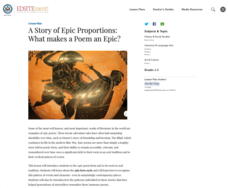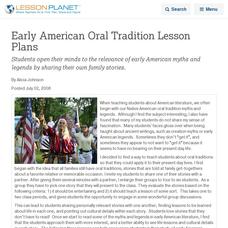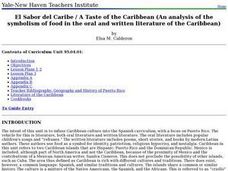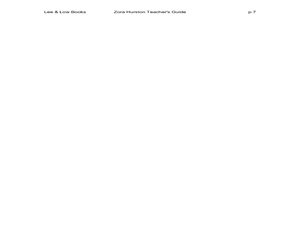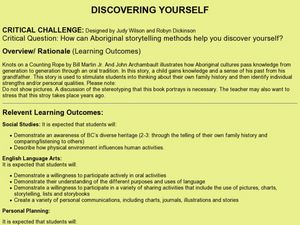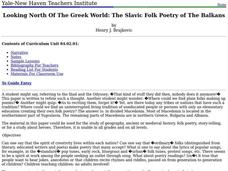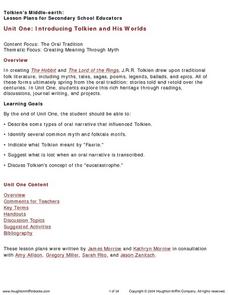National Endowment for the Humanities
A Story of Epic Proportions: What Makes a Poem an Epic?
Learners analyze the epic poem form and its roots in oral tradition. In this epic poetry lesson, students research the epic hero cycle and recognize the pattern of events and elements. Learners analyze the patterns embedded in the stories.
NWT Literacy Council
Readers Theatre Scripts
Engage and entertain young learners with this collection of readers theatre activities. With over 25 different scripts, a wide range of topics are covered from simple counting and rhyming exercises to adaptions of popular children's...
Curated OER
Early American Oral Tradition Lesson Plans
Students open their minds to the relevance of early American myths and legends by sharing their own family stories.
Curated OER
A Taste of the Caribbean
Pupils are introduced to the foods and traditions of the Caribbean. In groups, they brainstorm their own definition of culture and review the physical and political geography of the Caribbean. They spend time sampling different foods...
Curated OER
Understanding Folklife and Folklore
Student examine the basic characteristics of folklore. In this folklore lesson, students complete activities to identify two kinds of folk, folk groups, and folklife. Students list daily activities in their home, identify folk groups...
Curated OER
American Families: Portraits of African-American Families
Students develop a greater understanding and appreciation for their families. They increase personal self-esteem and pride as a result of studying about families through literature. They assess the importance of family values and...
Curated OER
Goldilocks Revisited
Second graders investigate the story of "The Three Bears" while focusing on the character of Goldilocks. They answer key questions that are focused upon the development of positive feelings and reactions. Students discuss the possible...
Curated OER
China: Culture and Young Adult literature
Eighth graders are introduced to Chinese language and culture to make Asian reading selections in literature circles more meaningful. They write about Chinese characters, work on oral speaking, and read Asian books and then have...
K20 LEARN
Here's How I Heard It: Using Folklore To Improve Close Reading Skills
"X" is for exaggeration, and "F" is for fact. To encourage close reading and to improve literary analysis skills, class members annotate fables and tall tales, like Paul Bunyan, with symbols that identify key features of this genre.
Penguin Books
A Teacher's Guide to the Penguin Edition of John Steinbeck's The Pearl
The guide to John Steinbeck's The Pearl suggests ways instructors can help readers see below the surface of the novella to the parable beneath. Through a variety of activities, readers come to appreciate the complexity of the tale.
Creative Competitions, Inc.
Odyssey of the Mind Curriculum Activity: Fantastic Fairy Tale
Learning about literature can be so much fun; it can also be made more accessible through projects and dramatic play. As they explore theme, character, and setting, the class gets creative and makes a dramatic recreation of a classic...
Curated OER
Seven Daughters and Seven Sons: the Middle East Through
Sixth graders read "Seven Daughters and Seven Sons" and examine aspects of Middle East culture and geography. They define vocabulary from the book and map locations described in the book.
Curated OER
Anglo-Saxon Period: An Introduction
Young scholars read information about Anglo-Saxon rulers and literary techniques, then complete a worksheet to help them review. Students take notes about the oral tradition, Anglo-Saxon literary terms, and Anglo-Saxon poetry. Young...
Curated OER
Growing Plants in Science and Literature, More Than an Empty Pot
Students read The Empty Pot as an introduction to plants. In this planting instructional activity, students understand a sequence of events in the book and relate it to the sequence of a plants life. Students grow plants and record...
Curated OER
Zora Hurston Teacher's Guide
Students explore American culture by reading classic literature in class. In this African-American history lesson, students read the story Zora Hurston and the Chinaberry Tree while identifying the work and contributions of the real life...
Curated OER
Art Critic for a Day!
Middle schoolers practice evaluating art by creating a research project and presentation. They use the Internet and library to discover a piece of art or artist whom they feel has an impact on the world of art. Next, they create a...
Curated OER
Personal Experience Narratives
Help your middle schoolers identify personal experience narratives in their own lives through telling stories themselves and from family members or other adults. They study personal experience narratives in Swapping Stories and compare...
Curated OER
Discovering Yourself
Students explore Aboriginal storytelling. In this literature lesson, students read Knots on a Counting Rope and then create a story line as they discuss the attributes of Aboriginal culture. Students retell the story in their own words.
Curated OER
Looking North Of The Greek World: The Slavic Folk Poetry of The Balkans
Showing how folk poetry keeps alive national heritage is the stated goal of this proposal for a unit on the poetry of the Balkans.
Curated OER
Introducing Tolkien and His Words
Students identify and describe the types of narratives that made Tolkien the writer he was. In groups, they examine different myths and folktale motifs. They discuss what Tolkien meant by "faerie" and "eucatastrophe." As a class, they...
Curated OER
Fables Unit Lesson Plan
Students study fables in a broad context. In this literary lesson on fables, students define terms unique to them. Students use a variety of technological resources to gather and classify information into three categories. Students also...
Curated OER
Tears of Joy Theatre Presents Anansi the Spider
Accompany the African folktale, Anansi the Spider, with a collection of five lessons, each equipped with supplemental activities. Lessons offer multidisciplinary reinforcement in English language arts, social studies, science,...
Annenberg Foundation
Slavery and Freedom
How do nineteenth-century texts by African American and Native American writers contribute to the country's ideals of freedom and individuality? Learners explore the topic by watching and discussing a video, reading biographies, writing...
Curated OER
From Remus to Rap: A History in Theory and Practice of the African-American Storytelling Tradition
Students examine the specific form and function of tall tales and toasts.
They discover the importance of performance in the telling of a story and the importance of rhythm in the telling of toasts. They create stories of their own, in...


